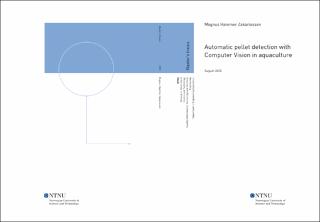| dc.contributor.advisor | Alver, Morten Omholt | |
| dc.contributor.author | Zakariassen, Magnus Hammer | |
| dc.date.accessioned | 2021-09-23T18:20:33Z | |
| dc.date.issued | 2020 | |
| dc.identifier | no.ntnu:inspera:56990118:34518679 | |
| dc.identifier.uri | https://hdl.handle.net/11250/2781007 | |
| dc.description.abstract | Matsvinn er et problem i oppdrettsnæring. Fôr som forblir uspist bidrar til store økonomiske tap i industrien, ettersom kostnader relatert til fôr utgjør 40-50\% av totale produksjonskostnader. Denne oppgaven undersøker om maskinsyn basert på dyp læring kan bidra til å automatisere hele eller deler av fôringsprosessen ved å automatisk detektere synkende pellets.
Løsningen benytter et konvolusjonelt nevralt nettverk, som regnes som state-of-the-art innen objektdeteksjon. Modeller basert på konvolusjonelle nevrale nettverk har levert gode resultater på klassifisering og detektering av objekter, og ses derfor på som et naturlig valg.
Modellen er foreløpig ikke robust nok til å helautomatisere oppdrettsanlegg, men viser lovende resultater i gitte situasjoner. Eksempelvis når pelletsene er i nærheten av kameraet og det er relativt uhindret sikt. Ut i fra resultatene er det tydelig at et større og mer robust datasett er nødvendig for å forbedre modellens ytelse. | |
| dc.description.abstract | The waste of fish food has is a serious problem in aquaculture. Any uneaten fish food contributes to economic loss in the industry, as costs related to food accounts for roughly 40-50\% of the total production costs in fish farming. This project researches the possibility of aiding in the automation of the feeding process through automatically detecting pellets leveraging computer vision and deep learning technology.
The solution utilizes a convolutional neural network, which is considerer to be state-of-the-art within object detection. Models based on convolutional neural networks have delivered respectable results within classification and detection of object, and is therefore a natural choice for this research.
The final model is currently not accurate enough for deployment in an industrial environment. However, the model shows signs potential in certain scenarios, namely when the pellets are in close proximity to the camera and has good visibility. From the end result it is apparent that further research with a larger, more robust dataset is necessary to improve the model's performance. | |
| dc.language | | |
| dc.publisher | NTNU | |
| dc.title | Automatic pellet detection with Computer Vision in aquaculture | |
| dc.type | Master thesis | |
